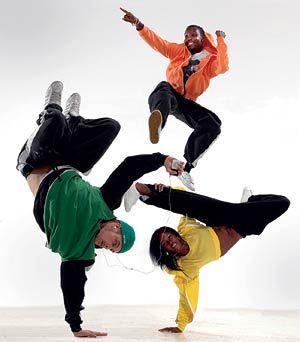Hip-hop is best recognized as an innovation of culture. Its deep essence promotes artistic originality and resourceful avenues of expression that have kept its traditions alive through fashion, art, music and dance.
Staying true to hip-hop, the olive Dance Theatre established its presence in Philadelphia by creating new dimensions of dance, particularly a form called “breakin’” a style that originated among New York City youth in the 1970s.
Since its beginnings in 2002, oDT has committed itself to communal education of the history and technicalities of breakin’, while nurturing experienced artists who are willing to develop their dance skills.
Breakin’ requires the body to take various acrobatic stances. The body is held up vertically or balanced with other limbs like the arms and even the head. Quick foot movements and body rotation are accompanied by the fast beats of music.

Culturally, a “B-boy” or a “B-girl” is the name of a person who executes these dance moves.
Artistic Director Jamie Merwin recruits people for oDT who share a “common vision” and focuses on how the company will benefit the dancer.
oDT recently hosted a free five-day concert series at the Wilma Theater in Philadelphia to showcase various works: tOy bOx, Strung, HearingLoss and Real Thing Come, Real Thing Go. Merwin mentioned that the week of performances was held to “create a greater public awareness of the aesthetic movement of hip-hop theater.”
Routinely, oDT welcomes feedback. Merwin encourages the audience to ask the dancers questions in an open forum after performances. He said he feels the audience often becomes insular from the dancers.
Since breakin’ is “a community base, cultural-specific dance,” audience perception is essential to creativity.
Audience members admit to having preconceived ideas of hip-hop dance before the show. They do not imagine the theatrical, narrative and multimedia elements that are delivered to enhance the senses and provide a variety of cultural perspectives.
Each dancer exhibits upper-body strength, quick foot movements and full flexibility of the body – skills essential to breakin’.
oDT principal “B-boy” dancers are Jaamal Benjamin, Julio ‘Cesa’ Zuniga and Brooks Jones.
Zuniga’s résumé includes being a teacher of breakin’, lockin’, poppin’ and house, which are other forms of dance that have developed from break dancing.
He said learning other styles of dance is practical.
For example, a ballet class teaches him to use his core muscles, but he “flips that and takes the concept of structure” and uses that in his own dancing.
Jones, who reunited with breakin’ after a 10-year hiatus, offered his thoughts on the dancing culture.
“You don’t start breakin’ to do a theatrical [performance]. You do it for a party,” Jones said.
The hip-hop culture has influenced urban communities nationally and abroad.
Bermuda native Mark “Metal” Wong acknowledged that his career evolved from an initial interest in “B-boy” dance to a passion for improving his skills. Even with credentials such as co-founding Repstyles Crew of Philadelphia, competing and performing regionally and nationally and establishing youth dance programs, Metal wants to focus on providing a positive message through breaking.
oDT admitted that the dance crews on the third season of MTV’s Randy Jackson Presents: America’s Best Dance Crew are talented, but Wong said that hip-hop has become commercialized. He has seen hip-hop transform from a cultural communication to a profitable business for many people.
Regardless of the commercialization of hip-hop, these “B-boys” and “B-girls” are committed to their roots of expression. Their distinctive backgrounds and creative visions are keeping hip-hop alive in Philadelphia.
Trenae McDuffie can be reached at trenae.mcduffie@temple.edu .


Be the first to comment